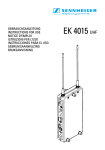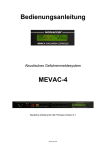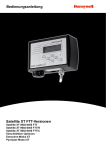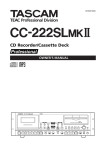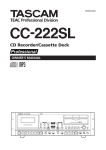Download MIC-AMP F355 - For-Tune
Transcript
BEDIENUNGSANLEITUNG USER´s MANUAL MIC-AMP F355 AVAILABLE MODELS MIC-AMP F350: MIC-AMP F355: 1-channel Microphone Preamplifier (available on request) 2-channel Microphone Preamplifier Inhalt / Content Allgemeine Sicherheitshinweise Das Erde / Masse Konzept Anschluss / Steckerbelegung Bedienungsanleitung Optionen General Safety Instructions The Earth / Grounding Concept Connection / Connectors User´s Manual Options Technische Daten / Technical Specifications Anhang / Supplement / Jumper Settings Konformitätserklärung / Conformity Statement Seite / Page 2 3 4 5 10 11 12 13 14 19 20 21 22 development and Turmstrasse 7a Tel. +49 (0) 7531 73678 manufacturing of 78467 Konstanz Fax +49 (0) 7531 74998 www.lake-people.de audio electronic GERMANY 1 Allgemeine Sicherheitshinweise WARNUNG Bitte lesen Sie die folgenden Sicherheitshinweise: Wasser, Flüssigkeiten, Feuchtigkeit: Das Gerät soll nicht in der Nähe von Wasser- oder Flüssigkeitsquellen benutzt werden. Das Gerät soll nicht in Bereichen grosser Feuchtigkeit betrieben werden. Achten Sie darauf, dass das Gerät nicht in Flüssigkeiten fällt oder dass Flüssigkeiten durch die Gehäuseöffnungen eindringen können. Betriebsspannung: Das Gerät darf nur mit den in dieser Bedienungsanleitung angegebenen Quellen betrieben werden. Erdung: Achten Sie darauf, dass dieses Gerät nur vorschriftsmässig geerdet betrieben wird. Netzkabel: Achten Sie auf einen einwandfreien Zustand des Netzkabels. Verlegen Sie das Netzkabel so, dass es nicht verletzt werden kann und keine Unfallquelle darstellt. Das Gerät wird mit einem 3-poligen Netzkabel mit deutschem Schuko-Stecker ausgeliefert. Auf Anfrage wird ein 3-poliges nordamerikanisches Netzkabel mitgeliefert. In einigen Ländern muss das Gerät mit einem vom Benutzer beigestellten Netzkabel betrieben werden. Übersicht: Netzkabelfunktionen und Farben Leiter / CONDUCTOR E Farbe COLOR Alternativ Alternativ L Phase LIVE Braun BROWN Schwarz BLACK N Null NEUTRAL Blau BLUE Weiss WHITE Erde EARTH GND Grün-Gelb GREEN+YELLOW Grün GREEN Netzsicherung: Die Netzsicherung dieses Gerätes ist eingelötet und nur von Innen zugänglich !! Eine durchgebrannte Sicherung weist auf interne Probleme hin und sollte nur im Rahmen von qualifizierten Service- oder Reparaturarbeiten ersetzt werden !! Umschaltbare Stromversorgung / Mehrbereichs-Stromversorgung Achten Sie auf den im Typenschild angegebenen Bereich der Versorgungsspannung, um einen sicheren Betrieb zu gewährleisten!! Dieses Gerät ist entweder mit einer intern umlötbaren Netzspannung 115 / 230 V AC oder mit einer Mehrbereichsspannung 90 ... 260 V AC ausgerüstet. Service / Reparatur: Um das Risiko von Feuer und Stromschlag zu reduzieren, soll dieses Gerät vom Benutzer nicht über die in dieser Bedienungsanleitung beschriebenen Arbeiten hinaus gewartet oder repariert werden. Überlassen Sie Serviceund Reparaturarbeiten qualifiziertem Personal !! VOR DEM ÖFFNEN NETZSTECKER ZIEHEN!! PULL MAINS BEFORE OPENING!! AVANT D´OUVRIER RETIREZ LA FICHE MALE!! Elektromagnetische Verträglichkeit: Dieses Gerät entspricht internationalen Spezifikationen, die am Ende dieser Bedienungsanleitung in der KONFORMITÄTSERKLÄRUNG beschrieben sind mit den folgenden Voraussetzungen: - dieses Gerät strahlt keine störenden Emissionen aus - dieses Gerät kann in störenden Umgebungen betrieben werden, auch wenn diese den beabsichtigten Einsatzzweck des Gerätes beeinträchtigen - der Betrieb dieses Gerätes in Umgebungen mit hohen elektromagnetischen Feldern sollte vermieden werden 2 Das Erde / Masse Konzept DIGITAL transformer balanced output XLR male 1 ANALOG transformer balanced output 2 Ground Lift Jumper: XLR male 2 G(round) L(ift) C(ase) 3 100n 3 1 XLR female DIGITAL transformer balanced input ANALOG transformer balanced input 2 2 3 DIGITAL unbalanced output ANALOG electronically balanced output Ground Lift Jumper: XLR male Cinch / RCA 2 DIGITAL unbalanced input ANALOG electronically balanced input Cinch / RCA G(round) L(ift) C(ase) 1 100n 3 solid Metal BNC G(round) L(ift) C(ase) 1 3 solid Metal BNC Ground Lift Jumper: XLR female 100n 1 Ground Lift Jumper: XLR female 2 G(round) L(ift) C(ase) 1 100n 3 AC Mains Socket E DIGITAL UNITS POWER SUPPLY ANALOG UNITS POWER SUPPLY ANALOG unbalanced output Cinch / RCA L N +18V AC IN Multirange Switchmode Supply 90 … 260 V AC In AC IN 5V DC stabilized Supply Voltage -18V (others) stabilized Supply Voltage Torroidal Transformer 230 / 115 V AC In ANALOG unbalanced input 100n 10k Cinch / RCA GND Lift GENERAL GROUND-LIFT JUMPER Earth / PE to Case ENCLOSURE General GROUND-LIFT Jumper (von aussen zugänglich): Ab Werk ist dieser Jumper auf GND/GROUND gesetzt. Der interne Masse-Bezugspunkt kann auf der Rückseite des Gerätes über den Jumper von GROUND auf LIFT gelegt werden. Die Verbindung zwischen internem Masse-Bezugspunkt und Erde wird hierbei für Gleichspannungen und niedrige Frequenzen (< 160 Hz) getrennt. Höherfrequente Störungen werden weiter nach Masse abgeleitet. Die LIFT-Stellung kann hilfreich sein wenn z.B. aufgrund verschiedener Massepotentiale Brumm oder Jitter generiert wird. Leider gibt es keine generelle Empfehlung, wie Brumm- oder Jitterstörungen zu vermeiden oder wenigstens zu reduzieren sind. Häufig muss probiert werden !! Bei symmetrischen Zuleitungen sollte auch immer überprüft werden, ob der Schirm Verbindung mit dem Stecker hat. Der Stecker wird IMMER über den 4. Kontakt der XLR Buchsen auf das Gehäuse-Potential gelegt !! Wie aus obiger Abbildung ersichtlich, kann das Masse/Erde-Verhältnis der ANALOGEN Ein- und Ausgänge modifiziert werden. Die elektrische Sicherheit immer gewährleistet, da der Schutzleiter PE fest am Gehäuse liegt !! XLR GROUD-LIFT Jumper (von innen zugänglich, SICHERHEITSHINWEISE beachten !! ): G(ROUND): Ab Werk sind alle Jumper auf G(ROUND) gesetzt. Pin 1 ist mit dem internen Masse-Bezugspunkt verbunden. HF Störungen werden über einen 100 nF Kondensator auf das Gehäuse abgeleitet. Pin 1 ist nicht mit dem internen Masse-Bezugspunkt verbunden. HF Störungen werden über einen L(IFT): C(ASE): 100 nF Kondensator auf das Gehäuse abgeleitet. Diese Stellung ist meist nur mit Transformatoren sinnvoll !! Pin 1 ist mit dem Gehäuse verbunden, der 100 nF Kondensator ist überbrückt. Diese Jumperstellung kann mir dem General GROUND-LIFT Jumper variiert werden. Sollte von den Werkseinstellungen abgewichen werden, können EMV Probleme entstehen. Diese liegen im Verantwortungsbereich des Nutzers !! 3 Anschluss / Steckerbelegung für analoge Signale ANALOGE SIGNALE SOURCE Symmetrisches Kabel (Signal) an (Trafo)symmetrischen Eingang XLR MALE PLUG Shield / Abschirmung = Signalmasse = Pin 1 2 1 HOT 3 COLD SHIELD X BALANCED INCOMING SIGNAL ANALOGE SIGNALE (Trafo)symmetrischer Ausgang an symmetrisches Kabel XLR FEMALE PLUG DESTINATION Hot / + Phase = Pin 2 Cold / - Phase = Pin 3 Das Steckergehäuse sollte nicht mit der Abschirmung des Kabels verbunden werden. Es wird beim Anschluss an das Gerät auf das Gehäusepotential (PE) gelegt ! 2 HOT 1 3 COLD SHIELD X BALANCED OUTGOING SIGNAL Shield / Abschirmung = Signalmasse = Pin 1 Hot / + Phase = Pin 2 Cold / - Phase = Pin 3 Das Steckergehäuse sollte nicht mit der Abschirmung des Kabels verbunden werden. Es wird beim Anschluss an das Gerät auf das Gehäusepotential (PE) gelegt ! ANALOGE SIGNALE SOURCE Unsymmetrisches Kabel (Signal) an (Trafo)symmetrischen Eingang XLR MALE PLUG Shield / Abschirmung = Signalmasse = Pin 1 2 HOT 1 3 GND SHIELD ? X BALANCED INCOMING SIGNAL 2-adrige Kabel sind zu bevorzugen !! ANALOGE SIGNALE Trafosymmetrischer Ausgang an unsymmetrisches Kabel DESTINATION XLR FEMALE PLUG 2 HOT 1 3 GND SHIELD Hot / Signal = Pin 2 Cold / Ground = Pin 3 Das Steckergehäuse sollte nicht mit der Abschirmung des Kabels verbunden werden. Es wird beim Anschluss an das Gerät auf das Gehäusepotential (PE) gelegt ! ? X BALANCED OUTGOING SIGNAL 2-adrige Kabel sind zu bevorzugen !! Shield / Abschirmung = Signalmasse = Pin 1 Hot / Signal = Pin 2 Cold / Ground = Pin 3 Das Steckergehäuse sollte nicht mit der Abschirmung des Kabels verbunden werden. Es wird beim Anschluss an das Gerät auf das Gehäusepotential (PE) gelegt ! ANALOGE SIGNALE DESTINATION Elektronisch symmetrischer Ausgang an unsymmetrisches Kabel XLR FEMALE PLUG Shield / Abschirmung = Signalmasse = Pin 1 2 HOT 1 3 GND SHIELD BALANCED OUTGOING SIGNAL 2-adrige Kabel sind zu bevorzugen !! X Hot / Signal = Pin 2 (Cold) = Pin 3 = unbedingt offen lassen !! Das Steckergehäuse sollte nicht mit der Abschirmung des Kabels verbunden werden. Es wird beim Anschluss an das Gerät auf das Gehäusepotential (PE) gelegt ! ANALOGE SIGNALE 4 HOT GND SHIELD UNBALANCED INCOMING SIGNAL DESTINATION SOURCE Unysmmetrischer Eingang / Ausgang an unsymmetrisches Kabel CINCH/BNC PLUG CINCH/BNC PLUG HOT GND SHIELD UNBALANCED OUTGOING SIGNAL ALLGEMEINES Optionen (siehe auch Seite 10) Der LAKE PEOPLE MIC-AMP F355 ist ein exzellenter, hervorragend ausgestatteter, extrem rauscharmer Mikrofon-Vorverstärker. Durch seine universelle Auslegung und hohe Pegelfestigkeit ist er auch zum Verstärken oder Symmetrieren von Line-Signalen geeignet. Das Verstärkungselement ist in der Grundausführung ein hochwertiger Instrumenten Verstärker. Optional kann der MIC-AMP F355 mit einem diskret aufgebauten Class-A Frontend ausgestattet werden. Die Verstärkung wird für jeden Kanal mit zwei Bedienelementen vorgenommen: Durch einen 12-stufigen Drehschalter lässt sich die Verstärkung in 6 dB Stufen von 0...+66 dB einstellen. Ein Poti mit Mittelrast erlaubt eine eventuell erforderliche Feineinstellung mit einem Einstellbereich von +/- 5 dB. Jeder Kanal verfügt über Taster für - Phantomspeisung - Pad - Phase-Reverse - (De-) aktivierung der "FINE" -Regelung - (De-) aktivierung des Lo-Cut Reglers - Mute Alle Taster besitzen LED's zur Rückmeldung des aktivierten Zustands. Um bei Bedarf den Signalweg so puristisch wie möglich zu halten, lässt sich die Elektronik der "FINE" -Regelstufe sowie die "LO-CUT"-Regelstufe per Tastendruck restlos aus der Schaltung entfernen. Beim an- oder abschalten der Phantomspeisung können die Ausgänge für ca. 4 Sekunden gemutet werden. Eine 16-stufige LED-Kette mit einem semilogarithmischen Anzeigebereich von 36 dB zeigt den Ausgangspegel an. Die Empfindlichkeit der Anzeige kann über einen Regler auf der Front einfach an die persönlichen Anforderungen angepasst werden. Eine Clip-LED blinkt bei Pegeln über +20 dBu und warnt zuverlässig vor Übersteuerungen. Die Ein- und Ausgänge befinden sich auf der Rückseite und sind elektronisch symmetrisch. Pro Kanal stehen zwei separate Ausgänge zur Verfügung. Jeder Kanal kann mit einer Class-A Eingangsstufe ausgerüstet werden. Jeder Ausgang kann mit einem ActiveFeedback Transformator versehen werden. Jeder Kanal kann mit einem GP-I/O versehen werden. DAS GEHÄUSE Das geerdete Gehäuse besteht aus 1 - 2 mm starkem Edelstahl. Dies garantiert eine hohe mechanische Stabilität und Widerstandsfähigkeit gegen rauhe Umwelteinflüsse. Durch die hohe elektrische Leitfähigkeit der unbehandelten Oberflächen ergeben sich hervorragenden EMV Eigenschaften. DIE STROMVERSORGUNG Die Stromversorgung erfolgt über eine eingebaute IEC-CEE-Dose. Wenn nötig, kann die Netzspannung intern von 230 auf 115 V umgestellt werden. Der "POWER"-Schalter befindet sich auf der Frontplatte. Der eingeschaltete Zustand wird durch eine LED unter dem "POWER"-Schalter angezeigt. Ein überdimensionierter Ringkerntrafo erzeugt die internen Betriebsspannungen. Es sind dies: - + 24V ungeregelt für LED´s und Relais - +/- 18V linear geregelt und stabilisiert für die analogen Schaltungen - + 5V linear geregelt und stabilisiert für die Prozessoren - + 48V über Schaltregler für die Phantomspannung DIE NETZSICHERUNG Die Sicherung 0,25 AT ist intern auf dem Netzteil-Print verlötet. ACHTUNG !! SICHERHEITSHINWEISE BEACHTEN: Eine durchgebrannte Sicherung weist auf interne Probleme hin und sollte nur im Rahmen von qualifizierten Service- oder Reparaturarbeiten ersetzt werden !! 5 THEORIE UND PRAXIS ZUR VERSTÄRKERSTUFE Die Verstärkung im MIC-AMP F355 erfolgt durch einen so genannten Instrumenten-Verstärker. Es ist ein für diese Zwecke optimiertes IC, dass sich durch seine Rauscharmut bei hohen Verstärkungen und seine hohe Breitbandverstärkung auszeichnet. Bei einer gewählten Verstärkung von +60 dB (1000-fach) ergibt sich ein Rauschen, dass lediglich 1-2 dB über dem theoretisch maximal erzielbaren Wert liegt. Die Breitbandverstärkung (GBW = Gain Bandwidth Product) und die Slew-Rate sind ursächlich für den Klang eines Verstärkers verantwortlich. Je höher sie ausfallen, desto transparenter ist der Klang. Die Slew-Rate des verwendeten Verstärkers ist 10 V/us, das GBW errechnet sich aus dem erzielten Frequenzgang bei einer bestimmten Verstärkung. Der MIC-AMP F355 hat bei einer Verstärkung von +60 dB einen internen linearen Frequenzgang von weit über 200 kHz. Daraus ergibt sich ein theoretisches GBW von 200 MHz (200.000 Hz * 1000). Optional kann der MIC-AMP F355 mit einer klassischen Class-A Eingangsstufe ausgerüstet werden. Gegenüber der Version mit Instrumenten-Verstärker ergeben sich kleine Nachteile im Bezug auf den Klirrfaktor bei hohen Eingangssignalen. Im für einen Mikrofon Vorverstärker relevanten Bereich von +10 ... +50 dB Verstärkung zeichnet sich die Class-A Version durch einen geringeren Klirrfaktor aus, bei höheren Eingangspegeln auch durch ein wesentlich geringeres Rauschen. ... wie es klingt ??? Nun, wir bei LAKE-PEOPLE geben uns schon immer jede erdenkliche Mühe, "Klang" zu vermeiden. Der Autor dieses Manuals ist der Meinung, das sich die Standard Version sehr gut für alle (Standard-) Anwendungen eignet, die Class-A Version hingegen ist prädestiniert für "Spezielles" Recording !! 6 DER SIGNALWEG UND DIE BEDIENELEMENTE DER EINGANG Der elektronisch symmetrische Eingang befindet sich auf der Rückseite des Gehäuses und ist mit einer XLR Buchse ausgestattet. Er ist mit "Input 1" bzw. "Input 2" bezeichnet. Der Eingang akzeptiert symmetrische und unsymmetrische Audiosignale. Die Belegung ist den internationalen Normen entsprechend - 1 = Masse - 2 = (+) Phase - 3 = (-) Phase Bei unsymmetrischem Abschluss des Eingangs sollte Pin 3 auf Masse gelegt werden. DIE PHANTOMSPEISUNG Hochwertige Kondensatormikrofone benötigen im allgemeinen eine Polarisations- oder Betriebsspannung, die so genannte Phantomspannung. Der MIC-AMP F355 stellt diese Spannung über den auf der Front befindlichen "PHANTOM"Taster zur Verfügung. Die aktivierte Funktion wird durch eine rote LED angezeigt. Sie beträgt ca. 48 Volt und wird gleichphasig über 6.8 kOhm Widerstände auf die Pins 2 und 3 der jeweiligen Eingangsbuchse gelegt. Bei üblichen Mikrofon Vorverstärkern führt das Ein- und Ausschalten der Phantomspannung konstruktionsbedingt zu niederfrequenten Spannungsänderungen am Ausgang, die nachfolgendes Equipment beschädigen können. Deshalb kann im MIC-AMP F355 ein AUTOMute-Vorgang von ca. 4 Sekunden beim Einund Ausschalten der Phantomspeisung programmiert werden. HINWEIS: Nach dem Einschalten der Phantomspannung stehen 48 Volt an den Pins 2 und 3 der jeweiligen Eingangsbuchse. Eventuell angeschlossenes LineLevel-Equipment - wie z.B. Synthesizer - kann hierdurch beschädigt werden. DIE BEDIENUNG (1 von 2 Modulen) AUTO-MUTE Um die Auto-Mute-Funktion zu kontrollieren oder zu verändern drücken Sie die Taste "PHANTOM" und halten sie gedrückt ! Nach zwei Sekunden fängt die "48V"-LED an zu blinken. Die LED über dem "MUTE"-Taster zeigt jetzt den Status der Auto-Mute Funktion. LED an: Auto-Mute aktiv LED aus: Auto-Mute nicht aktiv Das betätigen des "MUTE"-Tasters verändert den Zustand. Durch loslassen der "PHANTOM"-Taste wird der aktuelle Zustand gespeichert. DER PAD Der MIC-AMP F355 akzeptiert am Eingang Pegel bis +21 dBu. In einigen wenigen Anwendungsfällen kann sich diese sehr hohe Empfindlichkeit als nicht ausreichend erweisen. Um das Eingangssignal abzuschwächen, wird über den auf der Front befindlichen "PAD"Taster ein Spannungsteiler in die Leitung geschaltet. Er ist auf eine Dämpfung von 12 dB ausgelegt, womit sich die Eingangsempfindlichkeit auf +33 dBu erhöht. Der aktivierte Spannungsteiler wird durch eine rote LED angezeigt. Die Funktion wird ohne aktive Komponenten im Signalweg durch ein Relais realisiert. HINWEIS: Aktivieren Sie den PAD nur dann, wenn Sie ihn wirklich brauchen. Es tut keinem Signal gut, unnötig um 12 dB abgeschwächt und dann um denselben Betrag verstärkt zu werden. DIE PHASENUMKEHR Bei Aufnahmen mit mehreren Mikrofonen kann der Klangeindruck eventuell bedeutend verbessert werden, wenn die Phasenlage eines oder mehrerer Mikrofone invertiert wird. Sei es, weil die Mikrofonaufstellung dies erfordert, oder weil irgendwo ein falsch belegtes Kabel verwendet wird. Dies wird durch den "PHASE"-Taster ermöglicht. Er befindet sich auf der Front, die aktivierte Funktion (1800 Phasendrehung) wird durch eine gelbe LED angezeigt. Die Funktion wird ohne aktive Komponenten im Signalweg durch ein Relais realisiert. DIE VERSTÄRKUNGSEINSTELLUNG COARSE Das Eingangssignal gelangt über die rückseitige XLR Buchse auf die extrem rauscharme Verstärker-Zelle. 7 DIE BEDIENUNG (1 von 2 Modulen) Über den präzise rastenden 12-stufigen "COARSE"-Drehschalter auf der Front wird die Verstärkung in 6 dB Stufen von 0...+66 dB eingestellt. Die Genauigkeit beträgt min. +/- 0,3 dB über den gesamten Einstellbereich. auszublenden, verfügt der MIC-AMP F355 über einen zuschalt- und regelbaren Low-Cut Filter. Der "LO-CUT"-Regler steuert ein einstellbares zweipoliges Filter, der Regelbereich erstreckt sich von 10...250 Hz. LOW-CUT DE/AKTIVIEREN FINE Das "FINE"-Poti zur Feineinstellung der Verstärkung folgt auf die Eingangsschaltung. Der Einstellbereich beträgt ca. +/- 5 dB, die strategisch wichtigen +/- 3 dB Punkte sind auf der Skala markiert. Durch die Mittelrast des Potis ist die 0 dB Einstellung jederzeit leicht wieder zu finden. Über den "FILTER"-Taster auf der Front lässt sich die komplette Filterschaltung aktivieren oder deaktivieren. Der aktivierte Zustand wird über die grüne "ON"-LED über dem "FILTER"Taster signalisiert. Im deaktivierten Zustand sind sämtliche Schaltungsteile der Filterelektronik aus dem Signalweg entfernt. GAIN FINE DE/AKTIVIEREN MUTE Mit der "FINE"-Taste können die kompletten Schaltungsteile zur Feineinstellung aktiviert oder deaktiviert werden. Der aktivierte Zustand wird über die grüne "ON"-LED über dem "FINE"-Taster signalisiert. Im deaktivierten Zustand sind sämtliche Schaltungsteile der Einstell-Elektronik aus dem Signalweg entfernt. Mit dem "MUTE"-Taster kann eine Stummschaltung der Ausgänge ausgelöst werden. Die aktivierte Funktion wird über die rote "MUTE"LED signalisiert. HINWEIS: Ein Mute-Vorgang erfolgt automatisch für ca. 2 sec beim Einschalten des Gerätes und während des Ausschaltens. Siehe auch Seite 7 zum Thema Auto-Mute beim aktivieren/deaktivieren der Phantomspeisung. DER LOW-CUT FILTER Um störende und unnötige Frequenzen wie Popplaute und Griffgeräusche an Mikrofonen 8 DIE BEDIENUNG (1 von 2 Modulen) DIE PEGELANZEIGE DIE CLIPANZEIGE Die Empfindlichkeit der "OUTPUT LEVEL"Anzeige ist individuell kalibrierbar und deshalb in dBr (relativ) beschriftet. Die als Kreisausschnitt gestaltete Pegelanzeige aus 16 LEDs wölbt sich über dem Gain-Fine Regler. Sie ist semilogarithmisch ausgeführt mit 3 dB Abständen von –36 ... –12 dBr, 2 dB Abständen von –12 ... –4 dBr und 1 dB Abständen von –4 ... 0 dBr. Der Bereich von –36 ... –8 dBr leuchtet grün, der Bereich von –6 ... –2 dBr leuchtet gelb und die LEDs für –1 dBr und 0 dBr sind rot. Ein Vollwellen-Spitzenwert-Detektor (PPM) steuert die Anzeige nach DIN-Vorschrift mit einer Ansprechzeit von <10 ms und einer Abfallzeit von 1,5 s für 20 dB. Hinter dem mit "METER ADJUST" bezeichneten Durchbruch auf der Front befindet sich der mit einem kleinen Schraubenzieher justierbare Trimmer zur Empfindlichkeitsregelung. Der Einstellbereich ist ca. +6 ... +25 dBu für 0 dBr. HINWEIS: Ab Werk ist die rote 0 dBr LED auf einen Pegel von +15 dBu eingestellt. Die rote "CLIP"-LED befindet sich rechts vom "GAIN COARSE"-Drehschalter. Ihr Pegel ist fest eingestellt, sie beginnt über ca. +20 dBu zu blinken und warnt so vor drohenden internen Übersteuerungen. DIE AUSGÄNGE Der MIC-AMP F355 ist standardmässig mit zwei elektronisch symmetrischen XLR Ausgängen pro Kanal ausgestattet. Die Ausgänge befinden sich auf der Rückseite des Gehäuses. Sie sind als vergoldete XLR Verbinder ausgeführt. Die Belegung ist den internationalen Normen entsprechend - 1 = Masse - 2 = (+) Phase - 3 = (-) Phase HINWEIS: Es handelt sich um zwangssymmetrierte Ausgänge, d.h. die positive oder die negative Phase darf bei unsymmetrischem Abschluss nicht auf Masse gelegt werden sondern muss offen bleiben. Weiter stellt sich bei unsymmetrischem Abschluss ein Pegelverlust von 6 dB ein. 9 DIE OPTIONEN TRAFOSYMMETRSCHE AUSGÄNGE CLASS A FRONT-END Optional kann jeder Ausgang des MIC-AMP F355 mit einem Trafo ausgerüstet werden. Der verwendete Trafo ist aktiv rückgekoppelt und erreicht dadurch exzellente dynamische Werte. Optional kann jeder Kanal des MIC-AMP F355 mit einem Class-A Eingangsverstärker bestückt werden. Der Umbau sollte ab Werk oder nur von Fachpersonal vorgenommen werden. GP-I/O Diese optionale Schaltung erlaubt, die MuteFunktion des F355 extern auszulösen, oder über die intern oder extern ausgelöste Mute Funktion externe Prozesse wie z. B. Rotlicht zu steuern. RELAIS Das Relais wird gesteuert über das /Mute Signal. Im normalen Betrieb ist es aktiv, im MuteFall ist es abgefallen !! Auf dem Pin 1 des Sub-D 9 Steckers liegt der "normal offene (NO)" Kontakt des Relais, auf Pin 2 liegt der "normal geschlossene (NC)" Kontakt des Relais, auf Pin 6 liegt der Umschalter "Common“. STROMQUELLE Über Pin 7 des Sub-D 9 Steckers ist eine interne Stromquelle zugänglich. Bei einer Spannung von 24 V +/- 10% kann sie ca. 50 mA liefern. Die Stromquelle ist durch einen PTC gegen Überlast geschützt. MASSE Über Pin 3 ist die interne Masse zugänglich. 10 (ERDE) Das Gehäuse des Sub-D Steckers ist leitend mit dem Gehäuse des F355 verbunden, liegt also auf Schutzerde. Durch zwei Optokoppler kann über externe Signale ein interner Mute ausgelöst werden. OPTOKOPPLER 1 Die Lichtquelle des Optokoppler 1 wird intern versorgt. Über Pin 8 des Sub-D 9 Steckers kann dieser Optokoppler ein Mute auslösen, wenn Pin 8 auf Masse gelegt wird. OPTOKOPPLER 2 Der 2. Optokoppler kann über Pin 4 und Pin 9 erdfrei gesteuert werden. Ein Mute wird ausgelöst, wenn eine externe Spannung zwischen Pin 4 (+) und Pin 9 (-) gelegt wird. Der eingebaute Vorwiderstand ist für eine externe Spannung von 12 V optimiert !! General Safety Instructions WARNING For your protection, please read the following: Water, Liquids, Moisture: This appliance should not be used near water or other sources of liquids. Care should be taken so that objects do not fall and liquids are not spilled into the enclosure through openings. Power Sources: The appliance should be connected to a power supply only of the type described in the operating instructions or as marked on the appliance. Grounding: Care should be taken that this appliance is operated only properly grounded. Power Cord: Power supply cords should be routed so that they are not likely to be walked on or pinched by items placed upon or against them, paying particular attention to cords at plugs, convenience receptacles, and the point where they exit from the appliance. This unit is equipped with a 3-pole mains cable with German 3-pin mains plug. On request this units may be delivered with a 3-pole mains cable with North American 3-pin mains plug. In some countries this unit must be operated with a mains cable, supplied by the owner. Please refer to the table below to connect a mains plug: OVERVIEW: POWER CORD FUNCTION AND COLORS Leiter / CONDUCTOR L N E Phase LIVE Farbe COLOR Alternativ Alternativ Braun BROWN Schwarz BLACK Null NEUTRAL Blau BLUE Weiss WHITE Erde EARTH GND Grün-Gelb GREEN+YELLOW Grün GREEN U.K. Mains Plug Warning: A moulded mains plug that has been cut off from the cord is unsafe. Discard the mains plug at a suitable disposal facility. NEVER UNDER ANY CIRCUMSTANCES SHOULD YOU INSERT A DAMAGED OR CUT MAINS PLUG INTO A 13 AMP POWER SOCKET. Do not use the mains plug without the fuse cover in place. Replacement fuse covers can be obtained from your local retailer. Replacement fuses are 13 amps and MUST be ASTA approved to BS 1362. Mains Fuse: The mains fuse of this appliance is soldered in place and only accessible from the inside !! A burnt fuse may be an indicator of internal problems and should be replaced during a qualified servicing or repairing works !! Switchable Power Supply, Multimode Power Supply: Connect this unit only to the power source indicated on the equipment rear panel to ensure safe operation !! This unit is provided with either a internally solderable mains supply of 115 / 230 V AC or a multimode power supply which covers the range of 90 ... 260 V AC. Service / Repair: To reduce the risk of fire or electric shock, the user should not attempt to service the appliance beyond that described in the operating manual. All other servicing or repair should be referred to qualified personal !! VOR DEM ÖFFNEN NETZSTECKER ZIEHEN!! PULL MAINS BEFORE OPENING!! AVANT D´OUVRIER RETIREZ LA FICHE MALE!! Electromagnetic Compatibility This unit conforms to the Product Specifications noted as Declaration of Conformity at the end of this manual. Operation is subject to the following conditions: - this device may not cause harmful interferences - this device must accept any interference received, including interference that may cause undesired operation - this device must not be operated within significant electromagnetic field 11 The Earth / Grounding Concept XLR male 1 DIGITAL transformer balanced output ANALOG transformer balanced output 2 Ground Lift Jumper: XLR male 2 G(round) L(ift) C(ase) 3 100n 3 1 XLR female DIGITAL transformer balanced input ANALOG transformer balanced input 2 2 3 DIGITAL unbalanced output ANALOG electronically balanced output Ground Lift Jumper: XLR male Cinch / RCA 2 DIGITAL unbalanced input ANALOG electronically balanced input Cinch / RCA G(round) L(ift) C(ase) 1 100n 3 solid Metal BNC G(round) L(ift) C(ase) 1 3 solid Metal BNC Ground Lift Jumper: XLR female 100n 1 Ground Lift Jumper: XLR female 2 G(round) L(ift) C(ase) 1 100n 3 AC Mains Socket E DIGITAL UNITS POWER SUPPLY ANALOG UNITS POWER SUPPLY ANALOG unbalanced output Cinch / RCA L N +18V AC IN Multirange Switchmode Supply 90 … 260 V AC In AC IN 5V DC stabilized Supply Voltage -18V (others) stabilized Supply Voltage Torroidal Transformer 230 / 115 V AC In ANALOG unbalanced input 100n 10k Cinch / RCA GND Lift GENERAL GROUND-LIFT JUMPER Earth / PE to Case ENCLOSURE General GROUND-LIFT Jumper (accesible from the rear of the case): Ex works this jumper is plugged to GND/GROUND position. The internal ground potential, which is normally connected to the external earth reference at this point may be lifted with the aid of this jumper. As a result the interconnection for DC voltages and lower frequencies (< 160 Hz) will be cut. Higher frequency are allowed to find their way to earth potential through the RC filter. The LIFT position may be helpfull when e. g. because of different ground/earth potentials hum or jitter is generated. Unfortunately there is no general recommendation how to solve hum and jitter problems - or even minimize them. The best way to succeed is to check different options !! In case of balanced cables it should always been verified if the shield of the cable is connected to the body of the XLR connector. The connector is ALWAYS connected to Earth potential when plugged in !! Concerning ANALOG inputs and outputs, the relationship between ground and earth may be modified. In any case the electrical security is ensured, because the earth conductor is always connected to the enclosure !! XLR GROUD-LIFT Jumper (accesible from the inside, follow the SECURITY INSTRUCTIONS !! ): G(ROUND): Ex works all jumpers are set to G(ROUND) position. Pin 1 is connected to the internal ground reference. High frequency interferences are deflected to the case via a 100 nF capacitor. The interconnection between Pin 1 and ground is open. High frequency interferences are deflected L(IFT): to the case via a 100 nF capacitor. This jumper position is useful when the unit is equipped with transformers !! Pin 1 is connected to the case, the 100 nF capacitor is bridged. This jumper position may be varied C/ASE): together with the General GROUND-LIFT jumper. Please note that with jumpers in LIFT or GROUND position EMC problems might occure. Theses are in the field of the user´s responsibility !!!! 12 Connection / Connectors for Analog Signals ANALOG SIGNALS Balanced Cable (Signal) to (Transformer) Balanced Input 2 HOT 1 3 COLD SHIELD X BALANCED INCOMING SIGNAL ANALOG SIGNALS (Transformer) Balanced Output to Balanced Cable DESTINATION XLR FEMALE PLUG 2 HOT 1 3 COLD SHIELD X BALANCED OUTGOING SIGNAL ANALOG SIGNALS SOURCE 2 HOT 1 3 SHIELD ? X BALANCED INCOMING SIGNAL 2-wire cable should be prefered !! ANALOG SIGNALS DESTINATION 2 HOT 1 3 SHIELD ? X BALANCED OUTGOING SIGNAL 2-wire cable should be prefered !! ANALOG SIGNALS DESTINATION Shield = Signal Ground = Pin 1 Hot / Signal = Pin 2 Cold / Ground = Pin 3 The case of the connector should not be wired to the shield of the cable. The connector is routed to earth potential (PE) when plugged into the corresponding socket of the case ! Electronically Balanced Output to Unbalanced Cable XLR FEMALE PLUG 2 HOT 1 3 GND SHIELD BALANCED OUTGOING SIGNAL 2-wire cable should be prefered !! ANALOG SIGNALS CINCH/BNC PLUG SOURCE Shield = Signal Ground = Pin 1 Hot / Signal = Pin 2 Cold / Ground = Pin 3 The case of the connector should not be wired to the shield of the cable. The connector is routed to earth potential (PE) when plugged into the corresponding socket of the case ! Transformer Balanced Output to Unbalanced Cable XLR FEMALE PLUG GND Shield = Signal Ground = Pin 1 Hot / + Phase = Pin 2 Cold / - Phase = Pin 3 The case of the connector should not be wired to the shield of the cable. The connector is routed to earth potential (PE) when plugged into the corresponding socket of the case ! Unbalanced Cable (Signal) to (Transformer) Balanced Input XLR MALE PLUG GND Shield = Signal Ground = Pin 1 Hot / + Phase = Pin 2 Cold / - Phase = Pin 3 The case of the connector should not be wired to the shield of the cable. The connector is routed to earth potential (PE) when plugged into the corresponding socket of the case ! HOT GND SHIELD UNBALANCED INCOMING SIGNAL X Shield = Signal Ground = Pin 1 Hot / Signal = Pin 2 (Cold) = Pin 3 = must be left open !! The case of the connector should not be wired to the shield of the cable. The connector is routed to earth potential (PE) when plugged into the corresponding socket of the case ! Unbalanced Input / Output to Unbalanced Cable CINCH/BNC PLUG DESTINATION SOURCE XLR MALE PLUG HOT GND SHIELD UNBALANCED OUTGOING SIGNAL 13 GENERAL OPTIONS (see page 19 for more details) The LAKE PEOPLE MIC-AMP F355 is an extremely low-noise and fully featured microphone preamplifier with excellent specifications. Due to its versatile concept and high level capability it is also suitable for line signal boosting and balancing. The gain element of the standard version is a high quality instrumentation amplifier. As an option, MIC-AMP F355 may be equipped with a sophisticated Class-A frontend, built with discret components. Gain is controlled with two knobs per channel: a twelve-step rotary switch sets coarse gain in 6-dB steps from 0 to +66 dB. A centerdetented potentiometer allows fine adjustment within a range of +/- 5 dB. The lo-cut filter may be set individually from 10 to 250 Hz. Each channel is equipped with buttons for - Phantom powering - Pad - Phase reverse - (de-) activation of Gain-Fine adjust - (de-) activation of Lo-Cut control - Mute The state of all these buttons is reported by LEDs. In order to keep the signal path as pure as possible, the electronic components of the Gain-Fine control and the Lo-Cut filter stage may be removed completely with the aid of relais. Whilst switching on or off the phantom power, the outputs may be muted during 4 seconds. A sixteen-segment LED bargraph with semilogarithmical law displays the output level over a range of 36 dB. Display sensitivity can be adjusted to the user's requirements with a trim located on the front panel. A clip LED starts flashing at levels above +20 dBu and thus reliably warns against distortion. The electronically balanced inputs and outputs are situated on the rear panel. Each channel is equipped with two outputs. Each channel may be equipped with a Class-A input stage. Each output can be equipped with transformer balanced outputs consisting of active feedback transformers. Each channel may be equipped with a versatile GP-I/O interface. 14 THE CASE The grounded case is made of 1 -2 mm thick stainless steel. This provides high mechanical stability and resistance against rough handling. The cases surfaces are not treated with any material, so providing excellent electrical conductances for optimum EMC characteristics. THE POWER SUPPLY Mains is connected via a built-in IEC-CEE mains socket. If necessary, mains voltage can be internally altered from 230 to 115 V. The "POWER"-switch is situated on the front panel. Power status is displayed by a LED situated below the power switch. An oversized toroidal transformer delivers the internal supply voltages. These are: - +24 V unregulated for LED´s and relais - +/-18 V linear stabilized for the analog circuitry - +5 V linear stabilized for the processors - +48 V via DC/DC converter for phantom powering THE MAINS FUSE The 0,25 AT fuse is internally soldered in place on the power supply PCB. ATTENTION !! FOLLOW THE SAFETY INSTRUCTIONS: A blown fuse may refer to internal problems and should only been replaced during qualified servicing works !! THE AMPLIFIER STAGE: THEORY AND PRACTICE THE SIGNAL PATH AND THE CONTROLS The MIC AMP F355's gain is effected by a so called instrumentation amplifier. It is represented by an IC specially designed for this task, distinguishing itself by very low noise figures and a high gain/bandwidth product. When gain is set to +60 dB (x1000), the amount of noise added is only 1-2 dB more than the (theoretically) achievable minimum. The gain/bandwidth product (GBW) and the slew rate are basically responsible for the sonic quality of an amplifier. The higher they are, the more transparent the sound becomes. Slew rate is 10V/s, while the GBW is calculated from the frequency response at a certain gain ratio. The MIC AMP F355's internal linear frequency response at +60 dB gain exceeds 200 kHz. This results in a theoretical GBW as high as 200 MHz (200.000 Hz x 1000). As an option MIC-AMP F355 may be equipped with a Class-A input amplifier. It is the actual version of circuit designs which can be found in classic applications. Compared to the version with integrated instrumentation amplifier there are small disadvantages concerning THD when dealing with high level input signals. As the relevant operation range of a microphone preamplifier is a gain make-up of +10 … +50 dB, here the Class-A version shows lower THD. Also, with higher level signals the noise floor is significantly lower. THE INPUT … and how does it sound ??? Well, since the beginning we at LAKE PEOPLE spend lots of efforts to create no sounding instruments !! The author´s opinion is, that the standard version of MIC-AMP F355 is best suited for all standard applications. Whereas the Class-A version is predestinated for "Special" Recording. The balanced input is situated on the rear panel, fitted with XLR type socket. It is denoted "INPUT 1" and "INPUT 2" respectively. The input accepts balanced as well as unbalanced audio signals. XLR wiring corresponds to international standards with - Pin 1 = ground, - Pin 2 = + (in phase) and - Pin 3 = - (out of phase) If an unbalanced source is connected, one of the phases (preferably the negative one) should be connected to signal ground. PHANTOM POWERING The use of professional condenser microphones requires in general a polarisation voltage or operating voltage, the so called phantom power. The MIC AMP F355 offers a stabilized 48V phantom voltage, which is activated by the "PHANTOM"-button on the front panel. This voltage is applied to the input pins 2 and 3 via matched 6,8 kOhms resistors. Active phantom powering is indicated by the red "48V"-LED. Normal microphone preamplifiers will produce low-frequency voltage swing at their outputs when switching the phantom power on or off. This may damage subsequent equipment ! Therefore MIC-AMP F355 provides the "AUTO-MUTE"-feature which offers a 4-seconds output mute whilst switching pantom on or off. NOTE: If unbalanced equipment such as synthesizers etc. are connected to the MIC AMP F355's input, the 48V phantom voltage might cause damage if the connection is not made properly. This problem is faced with all phantom powered inputs and can be avoided by using a transformer coupled D.I. box or by strictly keeping the unbalanced wiring apart from pin 1 (ground). 15 THE OPERATION (1 of 2 Modules) AUTO-MUTE When engaged, the "AUTO-MUTE"-function will create a 4 seconds mute whilst switching phantom on or off. When you want to check or alter this function depress the “PHANTOM”-button permanently. After two seconds the "48V"-LED will start flashing and the “ON”-LED over the “MUTE”button shows the actual state of the Auto-Mute function. LED on: Auto-Mute enabled LED off: Auto Mute disabled Pushing the “Mute”-button will change the state. Releasing the “PANTOM” button will save the actual state. THE PAD The MIC AMP F355's inputs accept levels of up to +21 dBu. In some applications, this level capability may still not be sufficient. Therefore, a resistive network can be inserted into the signal path by pressing the "PAD"button. Offering an attenuation of 12 dB, it increases the maximum input level to +33 dBu. Active pad is indicated by the red “-12dB“-LED. This function is realized without active components in the signal path. 16 NOTE: The PAD-switch should only be used if really necessary. Otherwise an eventually redundant attenuation must be compensated by a higher gain setting, which practically means nothing else but decreasing signal-to-noise ratio. PHASE REVERSE In multiple microphone applications, inverting one or several microphones' phase can significantly improve the the overall mix. Reason therefore may be position-dependent time lags between microphones or, in the worst case, an incorrectly soldered microphone lead. The "PHASE"-button serves to invert signal polarity. It is situated on the front panel. The activated function is displayed by the yellow “REVERSE”-LED. This function is realized without active components in the signal path. GAIN SETTING COARSE The signal which is input to the XLR socket on the back is routed to the extremely low noise gain cell. THE OPERATION (1 of 2 Modules) By means of the precisely detentend 12-steps “COARSE”-rotary switch on the front panel gain is adjusted in steps of 6 dB from 0 … +66 dB. The deviation from the indicated value is less than +/- 0,3 dB. FINE The "FINE"-control is intended to precisely adjust the gain between two coarse steps. The setting range covers +/-5 dB. The important +/- 3 dB points are marked on the scale. Due to the center detent, the 'neutral' position of this control is easy to reproduce. DE/ACTIVATING GAIN FINE The complete electronic circuitry of the fine adjustement may be enabled/disabled by means of the “FINE”-button. The active state is displayed by the green “ON”-LED over the “FINE”-button. When disabled, the complete fine adjust circuitry is removed from the signal path. MIC-AMP F355 offers a variable Low-Cut Filter. The two-pole lowcut filter may be adjusted from 10-250 Hz by the "LOW-CUT"-Control. DE/ACTIVATING THE LOW-CUT The complete electronic circuitry of the low-cut filter may be enabled/disabled by means of the “FILTER”-button. The active state is displayed by the green “ON”-LED over the “FILTER”-button. When disabled, the complete filter-circuitry is removed from the signal path. MUTE The “MUTE”-button serves to mute the outputs of MIC-AMP F355. The enabled mute function is displayed by the red “ON”-LED over the “MUTE”-button. NOTE: An automatic mute is proceeded for 2 seconds during power-up and during shut down of MIC-AMP F355. Please refer also to “Auto-Mute” function whilst enable/disable phantom powering decribed on page 16. THE LOW-CUT FILTER In order to reduce undesired frequencies such as wind or microphone handling noise, the 17 THE OPERATION (1 of 2 Modules) THE LEVEL METER THE CLIP INDICATOR The sensitivity of the “OUTPUT LEVEL“-display is individually adjustabel and therefore indicated in dBr (relative). The level meter is designed as a sector of a circle consisting of 16 LEDs vaulting over the “GAIN FINE”-control. The display law is semi-logarithmic with 3 dB gaps between –36 … -12 dBr, 2 dB gaps between –12 … -4 dBr and 1 dB gaps between –4 … 0 dBr. The range from –36 … -8 dB consitst of green LEDs, while the range from –6 … -2 dBr is displayed by yellow LEDs. The LEDs for –1 dBr and 0 dBr are red. The full-wave peak detector (PPM) accurately controls the display at DIN specifications, with a rise time of <10 milliseconds and 1,5 seconds release time for a 20 dB level change. Behind the drilling denoted "METER-ADJUST" on the front panel, a trimmer accessible with a small screwdriver is provided for display range adjustment. NOTE: The standard factory setting is +15 dBu output level for a 0 dBr display. The red “CLIP”-LED is situated near to the “GAIN-COARSE”-control. It starts flashing at about +20 dBu and thus reliably warns against internal overload. The trigger is fixed and may not be altered. 18 THE OUTPUTS In its standard version, the MIC AMP F355 is equipped with two electronically balanced output per channel. All outputs are equipped with XLR sockets and situated on the rear panel. XLR wiring corresponds to international standards with - Pin 1 = ground, - Pin 2 = + (in phase) and - Pin 3 = - (out of phase). NOTE: In case of unbalanced termination neither the positiv nor the negative phase may be tied to ground. To prevent unwanted distortion, the not used output pin should remain open. In case of unbalanced termination the output level is reduced by 6 dB ! THE OPTIONS TRANSFORMER BALANCED OUTs CLASS-A FRONT END As an option each output may be equipped with high quality output transformers. These transformers are controlled by a special circuitry to achieve low inner resistance, very good frequency range and low distortions. They exceed IRT recommendations. As an option, each channel of MIC-AMP F355 may be equipped with a class-A input amplifier. This option should only be installed ex works or by trained professionals. GP-I/O This optional circuitry serves to externally actuate the mute function of F355 or to control external processes like “Rec-Light” by internally or externally released mutes. RELAIS The relais is controlled by the internal /Mute signal. During normal operation it is active, under mute conditions it is released !! Pin 1 of the Sub-D 9 connector is wired to the NO (normally open) contact of the relais. Pin 2 of the Sub-D 9 connector is wired to the NC (normally closed) contact of the relais. Pin 6 of the Sub-D 9 connector is wired to the Common contact of the relais. CURRENT SOURCE Pin 7 of the Sub-D 9 connector is wired to an internal current source. It delivers approx. 50 mA with a voltage of 24 V +/- 10%. The current source is protected against overload by means of a PTC. GROUND Via Pin 3 the internal ground is accessible. (PROTECTIVE EARTH) The case of the Sub-D connector is screwed to the case of F355 and therefore connected to protective earth. With the aid of two optocouplers an internal mute may be released by external signals. OPTOCOUPLER 1 This optocoupler is supplied internally. If Pin 8 from the Sub-D 9 connector is wired to ground this will release a mute. OPTOCOUPLER 2 This optocoupler may be controlled via Pin 4 and Pin 9 of the Sub-D 9 connector totally floating. A mute is released when an external voltage is connected to Pin 4 (+) and Pin 9 (-). The built-in resistor is optimized for 12 V external. 19 TECHNICAL DATA MIC-AMP F355 All measurements as not otherwise noted: RMS unweighted, 20 Hz - 20 kHz Inputs: Outputs: 2 x XLR female, electronically balanced 2 x 2 XLR male, electronically balanced, optional transformer Max. Input: +21 dBu, +33 dBu with pad Input Impedance: >2 kohms / >5 kohms with Pad Nominal input sensitivity: +6 dBu Input CMRR (100Hz): Input CMRR (15kHz): >78dB (A=0dB), >57dB (A=0dB), Gain Coarse: Gain Fine: 0 dB … +66 dB, 11 x 6dB steps -5dB…+5dB Phantom Voltage: Pad: Phase Reverse: Lo-Cut: 48V 12dB 180° 12Hz…250Hz adjustable Output Noise unwtd. (Rin = 200R) : Output Noise ‘A’ (Rin = 200R) : Output Noise ‘CCIR ’ (Rin = 200R) : <-94dBU (A=0dB), <-96dBU (A=0dB), <-83dBqp (A=0dB), Crosstalk (20Hz…20kHz): << -100dB >78dB (A=42dB), >87dB (A=42dB), >78dB (A=60dB) >84dB (A=60dB) <-84dBU (A=42dB), <-86dBU (A=42dB), <-72dBqp (A=42dB) <-68dBU (A=60dB) <-70dBU (A=60dB) <-56dBqp (A=60dB) A) Electronically balanced Outputs: Frequency range (-0.5dB): Frequency range (-3dB): 10Hz ... 61kHz (A=0dB), <5Hz … 165kHz (A=0dB), 12Hz ... 40kHz (A=60dB) <5Hz … 106kHz (A=60dB) Thd+N (20Hz…20kHz): pout = 6dBU @600R <-98dB (A=0dB), <-89dB (A=42dB), <-73dB (A=60dB) Thd+N (20Hz…20kHz): pout = 20dBU @600R <-96dB (A=0dB), <-96dB (A=42dB), <-84dB (A=60dB) Thd+N (1kHz): pout = 20dBU @600R <-99dB (A=0dB), <-99dB (A=42dB), <-88dB (A=60dB) Max. Output @600R: +23dBU Fine off, +26dBU Fine: +5dB Output CMRR (20Hz…20kHz): >80dB B) Transformer balanced Outputs: Frequency range (-0.5dB): Frequency range (-3dB): 10Hz ... 30kHz (A=0dB), <5Hz … 80kHz (A=0dB), Thd+N (40Hz…20kHz): pout = 6dBU @600R <-96dB (A=0dB), <-89dB (A=42dB), <-73dB (A=60dB) Thd+N (40Hz…20kHz): pout = 20dBU @600R <-90dB (A=0dB), <-90dB (A=42dB), <-83dB (A=60dB) Thd+N (1kHz): pout = 20dBU @600R <-98dB (A=0dB), <-98dB (A=42dB), <-87dB (A=60dB) Max. Output @600R: +22dBU Output CMRR (20Hz…20kHz): >60dB General Supply Voltage: Case: Front / Back: Dimensions: 20 230 / 115 V AC / 15 Watt Stainless Steel Aluminium, dark grey / Stainless Steel 19“, 1U, 483 x 44 x 166 (WxHxD) 12Hz ... 25kHz (A=60dB) <5Hz … 68kHz (A=60dB) PCB LAYOUT AND JUMPER SETTING MIC-AMP F355 C-L-G Pin 1 from XLR socket connected to internal Ground-Plane.. (ex Works setting) C-L-G Pin 1 from XLR socket lifted. C-L-G Pin 1 from XLR socket connected to case. GP-I/O OPTION Peak-Meter sensitivity adjustment Approx. +6 … +25 dBu for 0 dBr LED Ex Works adjusted to +15 dBu for 0 dBr LED 21 KONFORMITÄTSERKLÄRUNG CONFORMITY STATEMENT Wir bestätigen hiermit, dass das folgende Gerät: We herewith declare that the following unit: Bezeichnung: Name : MIC-AMP F355 Serien Nr. : -alle - MIC-AMP F355 Serial No: - all - mit folgenden EU-Richtlinien bzw. Normen übereinstimmt: is in conformity with the following EC directives: 73/23/ EWG neu 93/68/EWG; Niederspannungsrichtlinie 73/23/ EEC new 93/68/ EEC; Low voltage directive 89/336/EWG; Elektromagnetische Verträglichkeit 89/336/EEC; Electromagnetic compability Zur Beurteilung des Erzeugnisses hinsichtlich seiner elektromagnetischen Verträglichkeit wurden folgende, harmonisierten Vorschriften angewendet: For verification of conformity with regard to electromagnetic compability the following harmonized standards are applied: EN 50081-1 / 1992 Fachgrundnorm Störaussendung EN 50081-1 / 1992 Generic emission standard EN 50082-1 / 1997 Fachgrundnorm Störfestigkeit EN 50082-1 / 1997 Generic immunity standard Produktfamiliennorm für Audio- Video- und audiovisuelle Einrichtungen sowie für StudioLichtsteuereinrichtungen für professionellen Einsatz: Product family standard for audio, video, audio-visual and entertainment lightning control apparatus for professional use: EN 55103-1 / 1997 EN 55103-2 / 1997 Teil 1: Störaussendung Teil 2: Störfestigkeit Für diese Erklärung ist der Hersteller verantwortlich: EN 55103-1 / 1997 EN 55103-2 / 1997 Part 1: Emission Part 2: Immunity This declaration is given under responsibility of: Lake People electronic GmbH Turmstrasse 7a, D-78467 Konstanz ----------------------------------------------------------------------------Konstanz 15.06.2005, Fried Reim, Geschäftsführer / CEO 22 development and Turmstrasse 7a Tel. +49 (0) 7531 73678 manufacturing of 78467 Konstanz Fax +49 (0) 7531 74998 www.lake-people.de audio electronic GERMANY

























